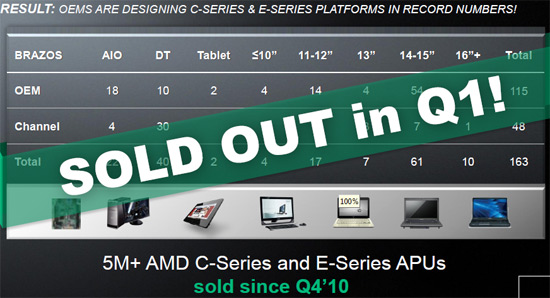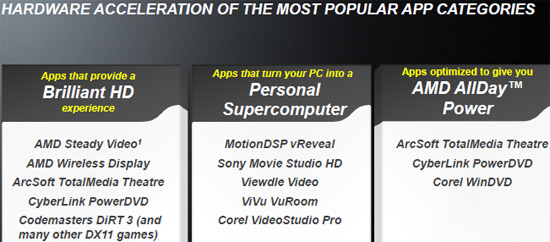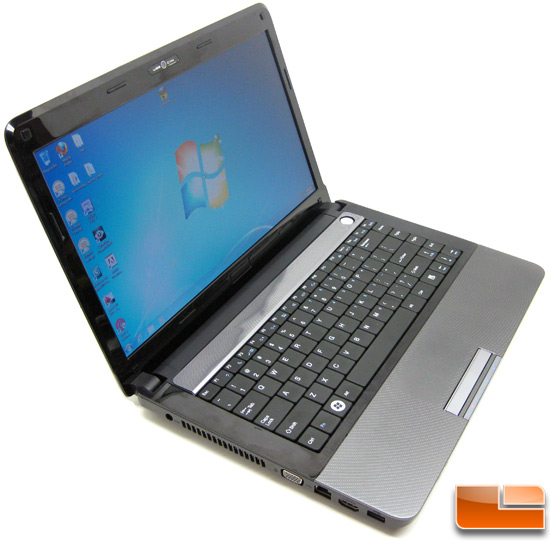AMD Llano A-Series APU Sabine Notebook Platform Review
Final Thoughts and Conclusions

AMD first released the APU to the public in January 2011 with the C and E Series APU, which were also known by the code name ‘Brazos’ by many in the tech industry. Brazos was aimed at entry level PCs, mainly netbooks, smaller notebooks, and even two tablet PCs. The C Series draws just 9 Watts and the E Series draws 18 Watts. We knew that AMD was selling these APUs and that they were doing well in the channel, but we were shocked to hear that they have sold over five million of those two APU series so far. That means that Llano, now formally named the AMD A Series APU, is the third generation APU from AMD. With Llano drawing 35 watts or 45 watts depending on the model it’s obviously a more powerful chip, but by no means excessively power hungry.
After spending a couple weeks with the AMD A-Series APU, I must say that I am very impressed by the performance that I am seeing on the Sabine platform. I knew that it would be more powerful than Brazos and the E-Series APU’s, but I wasn’t expecting such a big difference. AMD did a really good job on this platform and we hope that OEM’s pick up this platform design and put some marketing dollars behind it. The GPU performance of the A-Series APU is hands down the selling point for this platform. It’s hard to believe that the APU has that much GPU muscle inside and in a package that is just 35W to 45W TDP.

When the Llano graphics engine isn’t busy running your favorite games you can use it do do personal supercomputing, which means that you’ll be able to harness the as many as 400 Radeon graphics cores (depending on what A-series APU you get) to crank away on up to 500 Gflops of data at a time. This massive amount of parallel processing that’s available is unlike anything else on the market. This means that AMD is going to have to help create an ‘APU era’ in the months to come. AMD says that the A Series APU will be able to take advantage of over 50 applications from software developers at the time of launch that take advantage of graphics standards such as H.264, VC-1, MPEG-2 and MPEG-4 ASP/DivX and the OpenCL framework. AMD is going after heterogeneous computing in a very big way and once more software comes out that takes advantage of the GPU and the CPU on an APU, they will only get better. We know from experience that this ecosystem will take years to build, but AMD has a 4-way approach that they have started. They have solid ISV support, are helping software companies with developer solutions, setup the AMD fusion fund to help sponsor and fund groups and then of course they heavily support education through academia. AMD clearly standing behind the APU and it is the future of the company.

Battery life is huge when it comes to mobile devices and when you use something everyday you don’t want to be tied down by your battery. The AMD A-Series APU has battery life on par with the Intel Core i5 ‘Sandy Bridge’ processors when it comes to DVD playback (AMD lasted 1 minute longer), but far outperforms their processor when it comes to gaming. Let’s face it gaming is huge these days and most people play games on a daily basis. We were very impressed by what AMD has done with gaming on the battery. When we were gaming on the Intel platform we pulled the power during a game and the performance of the game didn’t change and the battery died in 75 minutes. We did the same thing on the AMD Llano notebook and when we unplugged the laptop we noticed the FPS performance decreased. AMD has some power saving measures taking place when the system is unplugged, but even though performance dropped the frame rate was still higher than the Intel system! The AMD system lasted an amazing 120 minutes on the battery when gaming, which was 45 minutes longer than the Intel notebook and both batteries are similar 6-cell batteries.
AMD Llano APUs will be available in notebooks ranging from $499 to $799 and after the performance numbers that we saw we believe they will do very well in the mainstream notebook market. For years Intel dominated the notebook market and for the first time in a decade the company needs to be worried. AMD has a mainstream notebook that excels at normal user tasks and destroys the games. Sure, the Intel ‘Sandy Bridge’ laptops rule the roost when it comes to CPU intensive tasks, but not too many people by a notebook in the $499 to $799 to do heavy tasks. People by mainstream notebooks to surf the web, share pictures and videos and play games. For that, the AMD ‘Sabine’ platform with the AMD A Series APU is the better solution as you can do more with the platform. Notebook and Desktop PC’s used to be benchmarked and used on a quarter mile race track and the one that was the quickest was the winner. Now we have a road course like the famous Nrburgring circuit where you have to have balanced solution in order to come out with the quickest time. The first battle between AMD and Intel on 32nm chips proved to be an interesting one and it’s only going to get more complicated as the months go on. Much of it will be taking advantage of the latest software for the new hardware that you just bought. To get the most from an APU you need to get the right software, so keep that in mind.
We can only hope that Lynx (Llano for desktop) will be even faster thanks to having much fewer power restrictions and higher clock frequencies. AMD is going to be very busy this year and APUs are clearly here to stay and we are glad to say that.

Legit Bottom Line: AMD Llano A-Series APUs usher in 32nm processors that are easily competitive with the competitors offerings and we think it has the right mix of GPU and CPU performance for the average PC user.

Comments are closed.